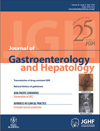Nuclear factor-kappa B as a promising target for selenium chemoprevention in rat hepatocarcinogenesis
Abstract
Background and Aims: Selenium's molecular mechanism for cancer chemoprevention remains unknown. We aimed to study the gene expression of nuclear factor-κB (NF-κB), tumor growth factor-α (TGF-α) and cyclin D1 and the effects of sodium selenite using preventive and therapeutic approaches in chemically-induced hepatocarcinogenesis in rats.
Methods: Rats were divided randomly into six groups: negative control, positive control (diethyl nitrosamine [DEN] + 2-acetylaminofluorene [2-AAF]), preventive group, preventive control (respective control for preventive group), therapeutic group and therapeutic control (respective control for therapeutic group). The relative gene expression of NF-κB, TGF-α and cyclin D1 in liver tissues were measured using real-time polymerase chain reaction.
Results: The findings showed that the gene expression of NF-κB in the preventive group and its respective control was significantly lower (P < 0.05) when compared with both the negative and positive controls. However, the expression of NF-κB in the positive controls and therapeutic group was significantly higher (P < 0.05) when compared with the negative controls. The expression of TGF-α and cyclin D1 was insignificant in all groups.
Conclusion: The inhibition of the NF-κB pathway in the initiation phase of hepatocarcinogenesis could be a promising target for selenium chemoprevention. However, further studies are required.




